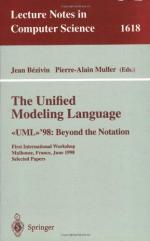|
This section contains 297 words (approx. 1 page at 300 words per page) |
A state transition diagram is a graphical representation of the states of an object as well as the transitions the object may pass through during its lifetime. State transition diagrams are used in object-oriented modeling and design to represent a finite-state machine.
In a state transition diagram circles represent states and directed line segments represent transitions between the states. A state is an observable mode of behavior of an object. At any time a particular object can only be in one state. Transitions can be internal events or events external to the system that have an effect on object states. Transitions may have conditions attached to them, meaning that a transition only occurs if a condition is true.
State transition diagrams were originally introduced by G. H. Mealy and E. F. Moore in the 1950s. Today's state transition diagrams are descendants of these models. The most popular implementation of state transition diagrams is the Harel statechart, developed by David Harel in 1983. On top of the basic state transition diagram concept, the Harel statechart includes the notions of hierarchy of state transitions as well as the ability to abstract common states into super-states. The Harel statechart has been adopted in the UML (Unified Modeling Language).
Creating a state transition diagram involves identifying all the possible states of the object, identifying all transitions between states, identifying the state the object is in when it is created, and identifying the state the object is in before it is destroyed.
State transition diagrams are best at describing the behavior of a single object. Since systems generally contain multiple objects, system analysis and design would consist of multiple state transition diagrams. Interaction diagrams (also called activity diagrams) are also used for describing behavior involving several objects.
|
This section contains 297 words (approx. 1 page at 300 words per page) |


